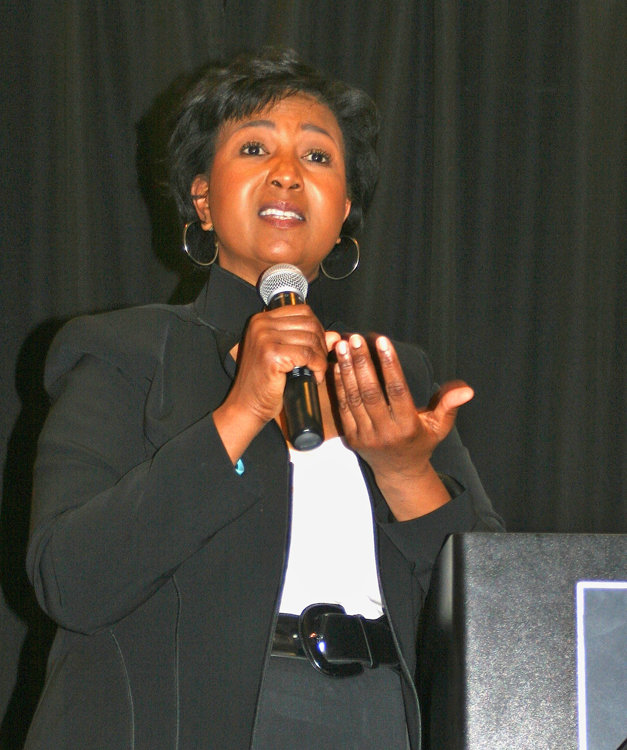
MSU’s “Slavery to Freedom” speaker series has featured some lofty rhetoric from the likes of Cornel West and Harry Belafonte, but Mae Jemison is the first one to address the audience as “earthlings.”
Jemison, the first African-American female astronaut, came to MSU Thursday to kick off this year’s series, sponsored by the College of Osteopathic Medicine and timed to coincide with Black History Month.
Jemison made a passionate case for space exploration as an inclusive, not exclusive, enterprise — a grand experiment with the potential to transform life on Earth.
Fueled by a potent mix of astronaut glamour and the authority of a civil rights icon, Jemison was uniquely suited to deliver a payload of optimism.
Hustling past the last minute, Kellogg Center staffers dragged in hundreds of extra chairs to accommodate a throng of arrivals until over 600 people circled the dais like the rings of Saturn.
Jemison, 60, drew an explicit link between social and technological progress.
In her youth, she recalled, scientific and social advances went hand in hand. She grew up in the 1950s and 1960s, when “it seemed like you had unlimited potential.”

NASA was founded in 1958, when the civil rights movement was entering its most active phase.
“Speed records were broken in the land and air, we were always finding a new subatomic particle,” she said. “People were claiming a right to participate. There was decolonialization, feminism, civil rights.”
She was a fan of the original “Star Trek” TV series and played with both Barbie dolls and chemistry sets.
“I wanted to dance like Lola Falana and Judith Jamison,” she said, giving equal credit to the sexy “queen of Las Vegas” and a famed dancer and artistic director of the Alvin Ailey Dance Co.
Jemison urged members of the audience at MSU, many of them teachers and community leaders, to use their “place at the table” to change society for the better.
“I had a whole bunch of umph and I would try different things, but I didn’t do it by myself,” she said. “Policies, the kinds of regulations we set up, do make a difference.”
Jemison said that if it had not been for Title IX, the federal law barring sex discrimination in any federally funded activity, she might not have become an astronaut.
She singled out President Lyndon Johnson as an object lesson in how to use, and how not to use, a “seat at the table.” As president, LBJ required that bidders for federal contracts adopt equal opportunity hiring practices. The rule opened opportunities for many women and African-Americans, especially in NASA facilities located in Huntsville, Ala., Houston and Cape Canaveral, Fla. all in the South.
But earlier as vice president, Johnson helped to stop the little-known “Mercury 13” group of women, many of them qualified test pilots, from making it into the first circle of astronauts.
Women didn’t get into the program until a class of six female shuttle astronauts was designated in 1979.
“Somebody used their place at the table to recruit,” Jemison said with a sly smile. She flashed a slide of one of her heroes, actress Nichelle Nichols, in the red outfit of Star Trek’s Lt. Uhura.
In the 1980s, Nichols volunteered her time to successfully recruit minority and female astronauts and staff for NASA, including administrator Charles Bolden, Jemison’s first boss at the agency. Nichols also promised to call NASA out if the agency failed to hire any of the women or African-Americans she helped recruit.
Jemison said the need is greater than ever for diversity in STEM (science, technology, engineering and mathematics) education.
Global questions about resource use are reaching a critical point, she said, and all hands are needed on deck to make sure “the planet survives our life form.”
“We always say that some clever person is going to come up with a way to make X, Y, Z and make everything OK,” she said. “But we’re trying to carve that path with less than two-thirds of the talent available to us.”
Jemison spent the rest of the talk describing “100 Year Starship,” a multi-disciplinary, privately funded project aimed at developing interstellar travel in 100 years. She is among the project’s co-founders and leaders.
The project does not envision traveling to another star many trillions of miles away as an end in itself.
To succeed, Jemison said, it would have to jumpstart revolutionary advances in energy generation and storage, sustainable resource management and human medicine.
She was careful not to describe the project as a Space Ark in which a select group of survivors escapes a doomed planet. She predicted that the vast majority of people living, and their descendants, will never leave the Earth.
“I don’t know if I want a Plan B for 100 folks and nobody else makes it,” she said. “We have to realize we’re all Earthlings.”
She went through the litany of advances already incubated by the U.S. space program, such as MRI, computer miniaturization, weather satellites and GPS.
“You have a space receiver in your hand,” she said, referring to everyone’s smart phone. “It’s these hurdles that drive our discovery, these radical advances we have to make in technology, systems and behavior, benefit us.”
Jemison tried, with limited success, to deflect her star power into rays of empowerment aimed at the audience.
In the Q&A after the talk, a woman asked Jemison how to instill ambition and confidence to become scientists or astronauts in her granddaughters.
Jemison told her high-profile “role models” are overrated.
“You are a role model,” she told the woman. “I’ve heard enough of older folks saying, ‘I can’t figure out how to program the Blu-Ray player, so I let my grandkids do it.’ There’s no way that’s ever cute.”
The Freedom to Slavery lecture series, sponsored by the Michigan State University College of Osteopathic Medicine, will continue with Washington Post journalist Jonathan Capehart on Thursday, Feb. 9, and Johnny Ford, the first African American mayor of Tuskegee, Ala., Feb. 23. Both talks are at 5 p.m. at MSU's Kellogg Hotel and Conference Center and free to the public.
Support City Pulse - Donate Today!
Comments
No comments on this item Please log in to comment by clicking here